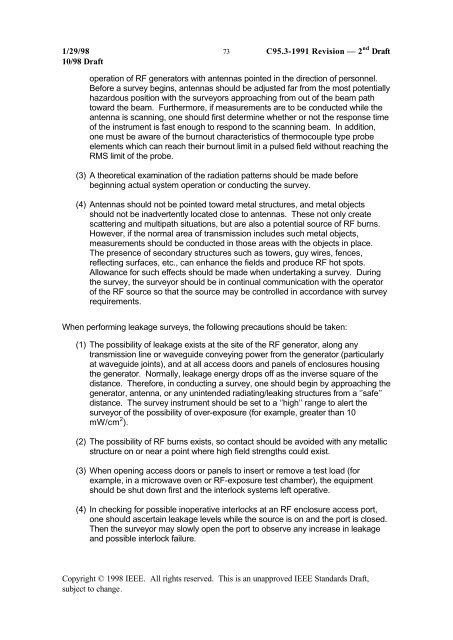DRAFT Recommended Practice for Measurements and ...
DRAFT Recommended Practice for Measurements and ...
DRAFT Recommended Practice for Measurements and ...
You also want an ePaper? Increase the reach of your titles
YUMPU automatically turns print PDFs into web optimized ePapers that Google loves.
1/29/98 73 C95.3-1991 Revision — 2 nd Draft<br />
10/98 Draft<br />
operation of RF generators with antennas pointed in the direction of personnel.<br />
Be<strong>for</strong>e a survey begins, antennas should be adjusted far from the most potentially<br />
hazardous position with the surveyors approaching from out of the beam path<br />
toward the beam. Furthermore, if measurements are to be conducted while the<br />
antenna is scanning, one should first determine whether or not the response time<br />
of the instrument is fast enough to respond to the scanning beam. In addition,<br />
one must be aware of the burnout characteristics of thermocouple type probe<br />
elements which can reach their burnout limit in a pulsed field without reaching the<br />
RMS limit of the probe.<br />
(3) A theoretical examination of the radiation patterns should be made be<strong>for</strong>e<br />
beginning actual system operation or conducting the survey.<br />
(4) Antennas should not be pointed toward metal structures, <strong>and</strong> metal objects<br />
should not be inadvertently located close to antennas. These not only create<br />
scattering <strong>and</strong> multipath situations, but are also a potential source of RF burns.<br />
However, if the normal area of transmission includes such metal objects,<br />
measurements should be conducted in those areas with the objects in place.<br />
The presence of secondary structures such as towers, guy wires, fences,<br />
reflecting surfaces, etc., can enhance the fields <strong>and</strong> produce RF hot spots.<br />
Allowance <strong>for</strong> such effects should be made when undertaking a survey. During<br />
the survey, the surveyor should be in continual communication with the operator<br />
of the RF source so that the source may be controlled in accordance with survey<br />
requirements.<br />
When per<strong>for</strong>ming leakage surveys, the following precautions should be taken:<br />
(1) The possibility of leakage exists at the site of the RF generator, along any<br />
transmission line or waveguide conveying power from the generator (particularly<br />
at waveguide joints), <strong>and</strong> at all access doors <strong>and</strong> panels of enclosures housing<br />
the generator. Normally, leakage energy drops off as the inverse square of the<br />
distance. There<strong>for</strong>e, in conducting a survey, one should begin by approaching the<br />
generator, antenna, or any unintended radiating/leaking structures from a ‘’safe’’<br />
distance. The survey instrument should be set to a ‘’high’’ range to alert the<br />
surveyor of the possibility of over-exposure (<strong>for</strong> example, greater than 10<br />
mW/cm 2 ).<br />
(2) The possibility of RF burns exists, so contact should be avoided with any metallic<br />
structure on or near a point where high field strengths could exist.<br />
(3) When opening access doors or panels to insert or remove a test load (<strong>for</strong><br />
example, in a microwave oven or RF-exposure test chamber), the equipment<br />
should be shut down first <strong>and</strong> the interlock systems left operative.<br />
(4) In checking <strong>for</strong> possible inoperative interlocks at an RF enclosure access port,<br />
one should ascertain leakage levels while the source is on <strong>and</strong> the port is closed.<br />
Then the surveyor may slowly open the port to observe any increase in leakage<br />
<strong>and</strong> possible interlock failure.<br />
Copyright © 1998 IEEE. All rights reserved. This is an unapproved IEEE St<strong>and</strong>ards Draft,<br />
subject to change.
















